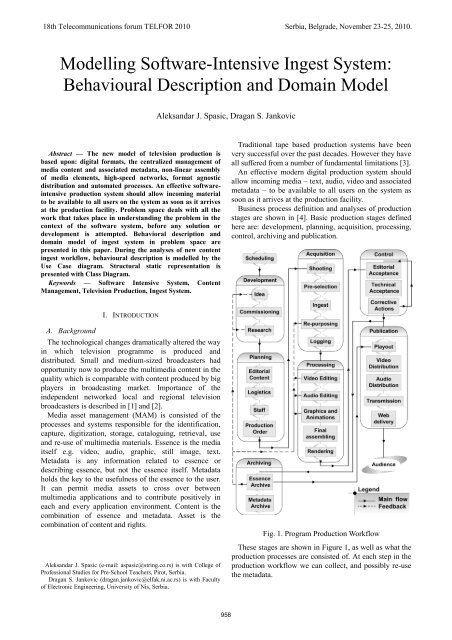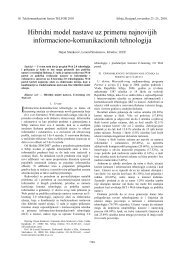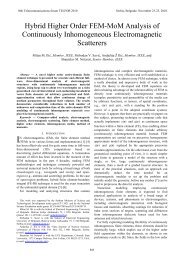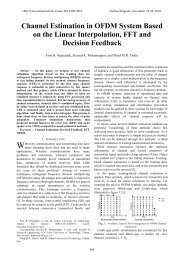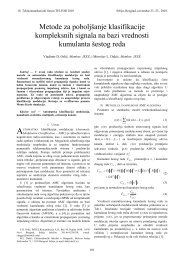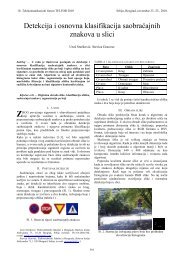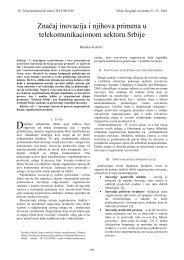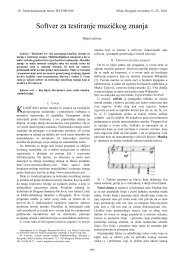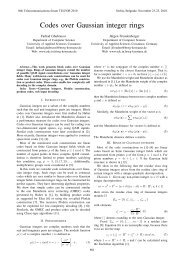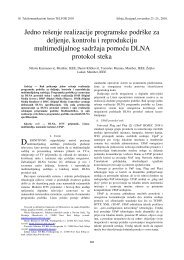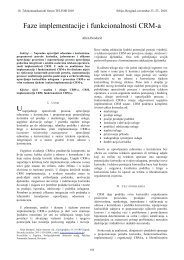TELFOR 2006 - 18. telekomunikacioni forum TELFOR 2010 - Telfor
TELFOR 2006 - 18. telekomunikacioni forum TELFOR 2010 - Telfor
TELFOR 2006 - 18. telekomunikacioni forum TELFOR 2010 - Telfor
You also want an ePaper? Increase the reach of your titles
YUMPU automatically turns print PDFs into web optimized ePapers that Google loves.
18th Telecommunications <strong>forum</strong> <strong>TELFOR</strong> <strong>2010</strong> Serbia, Belgrade, November 23-25, <strong>2010</strong>.<br />
Modelling Software-Intensive Ingest System:<br />
Behavioural Description and Domain Model<br />
Abstract The new model of television production is<br />
based upon: digital formats, the centralized management of<br />
media content and associated metadata, non-linear assembly<br />
of media elements, high-speed networks, format agnostic<br />
distribution and automated processes. An effective softwareintensive<br />
production system should allow incoming material<br />
to be available to all users on the system as soon as it arrives<br />
at the production facility. Problem space deals with all the<br />
work that takes place in understanding the problem in the<br />
context of the software system, before any solution or<br />
development is attempted. Behavioral description and<br />
domain model of ingest system in problem space are<br />
presented in this paper. During the analyses of new content<br />
ingest workflow, behavioural description is modelled by the<br />
Use Case diagram. Structural static representation is<br />
presented with Class Diagram.<br />
Keywords Software Intensive System, Content<br />
Management, Television Production, Ingest System.<br />
I. INTRODUCTION<br />
A. Background<br />
The technological changes dramatically altered the way<br />
in which television programme is produced and<br />
distributed. Small and medium-sized broadcasters had<br />
opportunity now to produce the multimedia content in the<br />
quality which is comparable with content produced by big<br />
players in broadcasting market. Importance of the<br />
independent networked local and regional television<br />
broadcasters is described in [1] and [2].<br />
Media asset management (MAM) is consisted of the<br />
processes and systems responsible for the identification,<br />
capture, digitization, storage, cataloguing, retrieval, use<br />
and re-use of multimedia materials. Essence is the media<br />
itself e.g. video, audio, graphic, still image, text.<br />
Metadata is any information related to essence or<br />
describing essence, but not the essence itself. Metadata<br />
holds the key to the usefulness of the essence to the user.<br />
It can permit media assets to cross over between<br />
multimedia applications and to contribute positively in<br />
each and every application environment. Content is the<br />
combination of essence and metadata. Asset is the<br />
combination of content and rights.<br />
Aleksandar J. Spasic (e-mail: aspasic@string.co.rs) is with College of<br />
Professional Studies for Pre-School Teachers, Pirot, Serbia.<br />
Dragan S. Jankovic (dragan.jankovic@elfak.ni.ac.rs) is with Faculty<br />
of Electronic Engineering, University of Nis, Serbia.<br />
Aleksandar J. Spasic, Dragan S. Jankovic<br />
958<br />
Traditional tape based production systems have been<br />
very successful over the past decades. However they have<br />
all suffered from a number of fundamental limitations [3].<br />
An effective modern digital production system should<br />
allow incoming media text, audio, video and associated<br />
metadata to be available to all users on the system as<br />
soon as it arrives at the production facility.<br />
Business process definition and analyses of production<br />
stages are shown in [4]. Basic production stages defined<br />
here are: development, planning, acquisition, processing,<br />
control, archiving and publication.<br />
Fig. 1. Program Production Workflow<br />
These stages are shown in Figure 1, as well as what the<br />
production processes are consisted of. At each step in the<br />
production workflow we can collect, and possibly re-use<br />
the metadata.
B. The Method<br />
A model, by its very nature, is an abstraction of the<br />
reality. The modeller, depending on his/her needs, keeps<br />
parts of the reality that are important to him/her in a<br />
particular situation and leaves out others which may be<br />
considered less important. Successful modelling needs to<br />
consider the areas in which modelling needs to take<br />
place. These modelling spaces have been formally<br />
considered and discussed by Unhelkar in [5]. The three<br />
distinct yet related modelling spaces are defined:<br />
problem, solution and background. These divisions<br />
provide a much more robust approach to modelling, as<br />
they segregate the models based on their purpose,<br />
primarily whether the model is created to understand the<br />
problem, to provide a solution to the problem, or to<br />
influence both of these purposes from the background,<br />
based on organizational constraints, and need to reuse<br />
components and services.<br />
In UML projects, model of problem space (MOPS)<br />
deals with creating an understanding of the problem,<br />
primarily the problem that the potential user of the system<br />
is facing. While usually it is the business problem that is<br />
being described, even a technical problem can be<br />
described at the user level in MOPS. In any case, the<br />
problem space deals with all the work that takes place in<br />
understanding the problem in the context of the software<br />
system, before any solution or development is attempted.<br />
Typical activities that take place in MOPS include<br />
documenting and understanding the requirements,<br />
analyzing requirements, investigating the problem in<br />
detail, and perhaps optional prototyping and<br />
understanding the flow of the process within the business.<br />
Thus the problem space would focus entirely on what is<br />
happening with the business or the user [6].<br />
The UML diagrams that helps express what is expected<br />
of the system, rather than how the system will be<br />
implemented, are Use Case diagrams. Use Case diagrams<br />
provide the overall view and scope of functionality. The<br />
use cases within these diagrams contain the behavioural<br />
(or functional) description of the system.<br />
Class diagram is used in this paper to provide the<br />
structure of the domain model. In the problem space,<br />
class diagrams represent business domain entities, not the<br />
details of their implementation in a programming<br />
language.<br />
II. INGESTION WORKFLOW<br />
During the acquisition stage, video shoots, audio clips<br />
and other programme items are created, pre-selected,<br />
ingested into production system and logged.<br />
The importance of the ingestion process is emphasized<br />
by Airola, Boch and Dimino in [7] and noticed that<br />
"crucial problem of Content Management Systems (CMS)<br />
is constituted by the ingestion of new content. As we<br />
cannot realistically expect that all the aspects of a<br />
production/archive environment are under the rules of a<br />
CMS, we need to set up gateways through which the<br />
content must pass when migrating from a non-managed<br />
environment to a CMS. The role of these gateways, that<br />
we call Ingestion Systems, is that of collecting and<br />
959<br />
organizing as many relevant information (metadata) on<br />
the item as possible ... ".<br />
Ingest is the first stage to efficiently transfer the content<br />
to the television production infrastructure. During the<br />
ingest we take all the content collected during a shoot, as<br />
well as new metadata, and transfer it into the production<br />
environment. We assume that the planning and<br />
commissioning metadata are already in the system. More<br />
metadata can be generated at ingest and this can either be<br />
directly entered, for example by an operator marking<br />
technically poor sections, or regions for special<br />
processing, or it can be extracted automatically.<br />
Simplified ingestion workflow is shown in Figure 2.<br />
Fig. 1. Ingest Workflow<br />
Ingestion can be considered in terms of two processes,<br />
or fundamental tasks:<br />
Content acquisition and optimization, and<br />
Content description and referencing.<br />
Content acquisition and optimization assume capturing<br />
the audio-video essence and content compression. The<br />
obvious capture device is the camera, but equally, sound<br />
effects, graphics, stills, captions and music may all be<br />
added. Typically, users of Content Management System<br />
will want to utilize high resolution master file (MPEG2<br />
encoded) which contains the content in professional<br />
broadcasting quality, as well as low resolution proxies of<br />
same content for searching and previewing archived<br />
material or for web delivery. Ingest system should<br />
provide automatic generation of high and low resolution<br />
content representations.<br />
During the content optimization the key frames should<br />
be extracted and recorded. Key frames are valuable for<br />
providing asset management solutions with representative<br />
images for browsing video, as well as for making edit<br />
decisions. Key frames should be extracted and converted<br />
to JPEG images based on scene changes or predefined<br />
time intervals.<br />
At all points in capture there is an opportunity for<br />
metadata collection. Some of the metadata, like<br />
<br />
captured by direct entry at the time of shooting. The<br />
metadata at this point in the chain should be viewed as<br />
Also, technical<br />
metadata, like time code information or light information<br />
can be captured from camera. Manual adding of metadata<br />
for description and indexing of content, however, should<br />
significantly enrich the content and support the asset<br />
management applications.
III. MODELLING BEHAVIOURAL DESCRIPTION OF INGEST<br />
PROCESS<br />
The main objective of a behavioural description is to<br />
visualize how the user (represented by the UML actor)<br />
will interact with and use the system. This is done by<br />
showing the actor associating with one or more use cases<br />
and, additionally, by drawing many use case diagrams.<br />
Main actors in problem space of ingest process are<br />
producer, ingest operator, essence gathering crew<br />
(cameraman, sound recorder) and ingest automated<br />
system.<br />
Use cases important for modelling in problem space of<br />
ingest process are as follows: Ingest planning, Setup<br />
criteria for indexing, Start acquisition, Automated<br />
metadata generation, Manual metadata enrichment,<br />
Indexing, Encoding multiple formats and Delivery to<br />
Archive. Use Case diagram is shown in Figure 3.<br />
Fig. 2. Use Case diagram of Ingest Process<br />
A. Use Case - Start Acquisition<br />
Short Description: Video shoots, audio clips and other<br />
essence items, as well as attached metadata are extracted<br />
from the continuous acquisition bin, such as cameras,<br />
sound recorders, digital tape players, different editing<br />
workstations, servers etc.<br />
Actors: Ingest operator and essence gathering crew<br />
members.<br />
Pre-Conditions: Video essence (footage) is shoot, audio<br />
essence is recorded, other program items are created and<br />
pre-selected.<br />
Post-Conditions: All essence materials, as well as<br />
related metadata, are ingested into production system.<br />
Main Flow: (1) Ingest operator starts acquiring the raw<br />
material or previously produced essence from cameras or<br />
other sources. (2) During ingest all the content collected<br />
during a shoot, recording and repurposing, as well as new<br />
metadata is taken and transferred into the production<br />
960<br />
environment. (3) Ingest operator reviews what he/she has,<br />
and marks down its possible use. Use Case terminates.<br />
B. Use Case - Indexing<br />
Short Description: Ingest system extracts a number of<br />
key attributes from the source essence and converts them<br />
to metadata.<br />
Actors: Ingest automated system.<br />
Pre-Conditions: Criteria for indexing are defined and<br />
parameters are setup.<br />
Post-Conditions: Key attributes are extracted and<br />
related metadata are produced.<br />
Main Flow: (1) System analyzes the acquired essence<br />
in accordance with parameters which are previously setup.<br />
(2) Metadata generator module produces related<br />
metadata. Use Case terminates.<br />
C. Use Case - Automated metadata generations<br />
Short Description: System generates metadata from the<br />
acquired essence files.<br />
Actors: Ingest automated system.<br />
Pre-Conditions: Essence material, as well as files with<br />
related metadata, are ingested into production system.<br />
Post-Conditions: Metadata are stored in database.<br />
Main Flow: (1) System search for metadata files<br />
accompanying acquired essence. (2) System checks the<br />
metadata format and if metadata format is in accordance<br />
with systems metadata formats, metadata are stored in<br />
database. (3) If metadata format does not confirm,<br />
corrective actions must be undertaken [alternate flow A1].<br />
(4) Steps (1) and (2) are repeated until all metadata is<br />
generated and Use Case terminates.<br />
Alternate Flow (A1): No need for corrections. Metadata<br />
are approved and stored in database.<br />
D. Use Case - Manual metadata enrichment<br />
Short Description: Automatic extracted metadata can be<br />
validated. New metadata (descriptions, business<br />
information etc.) can be added.<br />
Actors: Ingest operator, Essence gathering crew<br />
member.<br />
Pre-Conditions: Essence material, as well as files with<br />
related metadata, including indexed and generated<br />
metadata are ingested into production system.<br />
Post-Conditions: Stored essence, as well as related<br />
metadata.<br />
Main Flow: (1) Ingest operator validates previously<br />
generated indexes and metadata. (2) Ingest operator add<br />
new descriptions of essence. Use Case terminates.<br />
E. Use Case - Encoding multiple formats<br />
Short Description: Create high-resolution master<br />
essence file and low-resolution proxy file.<br />
Actors: Ingest automated system.<br />
Pre-Conditions: Essence acquired, metadata generated<br />
and stored in database.<br />
Post-Conditions: Essence encoded in hi-resolution<br />
version and stored in archive. Essence encoded in lowresolution<br />
version and delivered to stream server.<br />
Main Flow: (1) In accordance with production format<br />
essence is encoded in high quality broadcast format
(usually MPEG2). (2) Essence is encoded in several<br />
different versions of low-res. files. Use Case terminates.<br />
F. Use Case Delivery to Archive and Stream Server<br />
Short Description: System stores essence in deep<br />
archive and send low-resolution proxies to stream server.<br />
Actors: Ingest automated system.<br />
Pre-Conditions: Essence is encoded in hi-res version.<br />
Essence is encoded in low-resolution version.<br />
Post-Conditions: Essence is stored in archive. Essence<br />
is delivered to stream server.<br />
Main Flow: (1) System stores essence in deep archive.<br />
(2) System delivers low-resolution proxies to stream<br />
server which serves low-resolution proxies for searching,<br />
previewing, non-linear editing etc. Use Case terminates.<br />
IV. DOMAIN MODEL OF INGEST PROCESS<br />
The objective of modelling structural static<br />
representation is to represent, in one or more views,<br />
various business entities and their relationships in MOPS.<br />
Class diagrams, by their very nature, are very strong,<br />
structural, static representations. Class diagrams show<br />
business-level classes as well as technical classes derived<br />
from the implementation language. In addition to<br />
showing the classes, class diagrams show the<br />
REFERENCES<br />
[1] Informing Citizens in a Highly Restrictive<br />
Environment Using Low-Budget Multimedia Communications: A<br />
Informing Science Journal, vol. 8, pp 245-<br />
262., 2005.<br />
[2] A. Spasic, M. Informing Citizens in a Highly Restrictive<br />
Environment Using Low-Budget Multimedia Communications: A<br />
Foundations of Informing Science: 1998-<br />
2008, .G. Gill, E. Cohen, Eds, Informing Science Institute, Santa<br />
Clara, California, USA, (2009),Part IV: Applied Informing Science,<br />
ch. 17: pp. 577-617.<br />
[3] <br />
<br />
(IBC 2000), Amsterdam, IEE Conf. Publication, 2000, Available:<br />
http://www.bbc.co.uk/rd/pubs/papers/pdffiles/ibc00jh.pdf.<br />
Fig. 4. Class diagram: Domain Model of Ingest Process<br />
961<br />
relationships between them. The entire description of the<br />
s they may be called in the<br />
problem space) and their relationships with each other is<br />
static. No dependency is shown in this diagram and no<br />
concept of time. Class diagram of the ingest process is<br />
shown in Figure 4.<br />
V. CONCLUSIONS<br />
The primary aim of this paper was to describe ingest<br />
system as one of the main areas in a production<br />
environment and to summarize the essence, metadata and<br />
control flow, as well as the main processes involved in a<br />
typical ingesting of television content.<br />
The first step in modelling of software intensive ingest<br />
system, modelling of problem space, is presented here.<br />
Use Case diagram is used as an ultimate tool for<br />
behavioural description of the ingest system. Class<br />
diagram is used for description of Domain model.<br />
The challenge for the future is to make complete<br />
business analysis of problem space using the use case,<br />
class, activity, state machine and sequence diagrams.<br />
Also, the model of solution space, as well as the model of<br />
background space should follow the current work<br />
presented in this paper.<br />
[4] -Intensive Television<br />
, Serbian<br />
Journal of Management, vol. 1, no.2, pp. 17-32, <strong>2006</strong>.<br />
[5] B. Unhelkar B, Verification and Validation for Quality of UML 2.0<br />
Models, John Wiley & Sons, Inc. Hoboken, New Jersey, 2005.<br />
[6] M. , Object-Oriented Analysis and Design:<br />
Understanding System Development with UML 2.0, John Wiley &<br />
Sons Ltd., Chichester, West Sussex, 2005.<br />
[7] <br />
presented at International Broadcasting<br />
Convention (IBC 2002), Amsterdam, IEE Conf. Publication, 2002<br />
MODELLING SOFTWARE-INTENSIVE INGEST<br />
SYSTEM: BEHAVIOURAL DESCRIPTION AND<br />
DOMAIN MODEL<br />
Aleksandar J. Spasic, Dragan S. Jankovic


